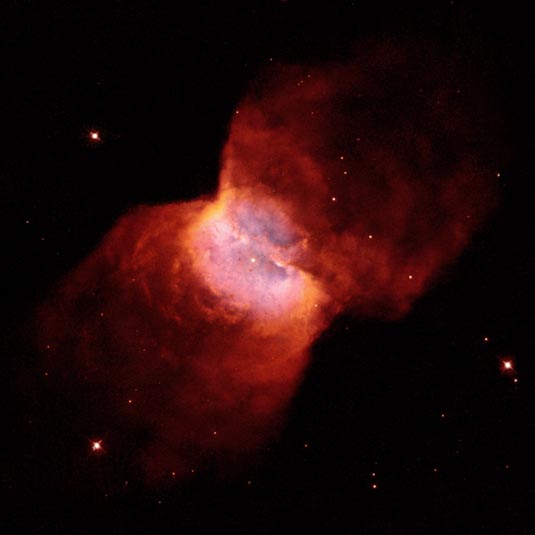
Planetary Nebula
RA 07hr 09m 22.524s Dec -00° 48' 23.62"
Monoceros
2300 light years
11.6
NASA/ESA and The Hubble Heritage Team (AURA/STScI)
October 7, 1999
ABOUT THIS IMAGE:
NGC 2346 is a so-called "planetary nebula," which is ejected from Sun-like stars which are near the ends of their lives. NGC 2346 is remarkable because its central star is known to be actually a very close pair of stars, orbiting each other every 16 days. It is believed that the binary star was originally more widely separated. However, when one component of the binary evolved, expanded in size, and became a red-giant star, it literally swallowed its companion star. The companion star then spiraled downwards inside the red giant, and in the process spewed out gas into a ring around the binary system. Later on, when the hot core of the red giant was exposed, it developed a faster stellar wind, which emerged perpendicularly to the ring and inflated two huge "bubbles". This two-stage process is believed to have resulted in the butterfly-like shape of the nebula. NGC 2346 lies about 2,000 light-years away from us, and is about one-third of a light-year in size.
From
Wikipedia:
NGC 2346 (also known as the Butterfly Nebula) is a planetary nebula near
the celestial equator in the Monoceros constellation. It is bright and
conspicuous and has been extensively studied. Among its most remarkable
characteristics is its unusually cool central star, which is a spectroscopic
binary, and its unusual shape.
The binary star, which has a period of about 16 days, is also variable, probably due to dust in orbit around it. The dust itself is heated by the central star and so NGC 2346 is unusually bright in the infrared part of the spectrum. When one of the two stars evolved into a red giant, it engulfed its companion, which stripped away a ring of material from the larger star’s atmosphere. When the red giant’s core was exposed, a fast stellar wind inflated two ‘bubbles’ from either side of the ring.